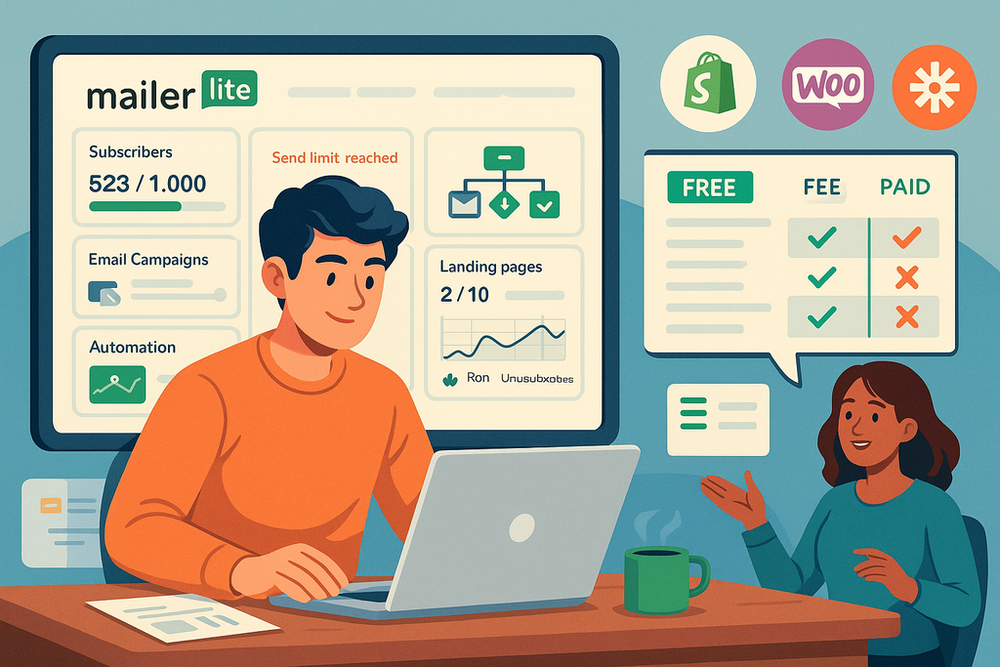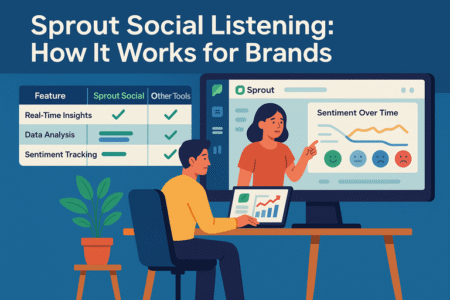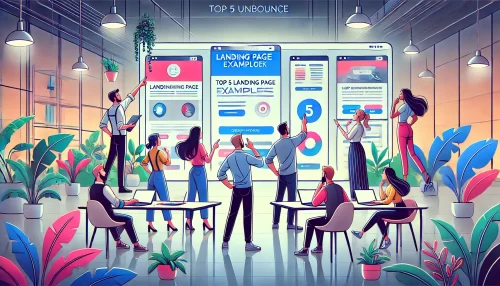Table of Contents
MailerLite free is one of those offers that looks tempting, but what do you actually get without paying a dime?
Can you really build professional email campaigns on the free plan, or are you going to hit a wall the moment your list starts growing? Is it missing crucial tools you’ll need to compete with bigger senders?
Let’s break down exactly what the free version includes and where its limits might leave you wanting more.
How Many Subscribers You Can Manage on MailerLite Free
The MailerLite free plan isn’t just a teaser—it actually gives you enough room to get started with real email marketing.
But the big question is: How many people can you actually manage before you need to pull out your wallet?
Subscriber Limit and Contact Management Explained
With MailerLite free, you can manage up to 1,000 subscribers at no cost. That means you can collect email addresses, organize them into groups, and send campaigns to all of them without upgrading. For small businesses, side hustles, or creators just starting out, this limit is generous compared to other tools that cap you at just a few hundred.
Inside the dashboard, you’ll see a Subscribers tab where you can manually add contacts, import spreadsheets, or sync with integrations. The system doesn’t just store emails—it lets you add custom fields (like “first name” or “favorite product”) so you can personalize campaigns even on the free plan.
I suggest taking advantage of groups and segments early. Groups are like manual tags you assign (e.g., “VIP customers”), while segments are smart filters (e.g., “people who opened an email in the last 30 days”). Even on the free tier, these tools help you avoid blasting the same generic message to everyone.
What Happens If You Go Over the Free Plan Limit
Here’s the part you need to watch: Once you cross 1,000 subscribers, MailerLite doesn’t immediately cut you off, but you’ll be prompted to upgrade before you can continue sending. Think of it like hitting the ceiling in a free trial—it won’t delete your contacts, but your sending abilities will freeze.
If you’re close to that limit, I recommend cleaning your list before upgrading. MailerLite makes it easy to filter out inactive or bounced emails. By trimming dead weight, you stay under the cap longer and keep your deliverability healthy.
Importing, Segmenting, and Cleaning Lists Without Paying
One of the nice surprises with MailerLite free is that you’re not restricted to tiny imports. You can upload CSV or TXT files directly under Subscribers > Add Subscribers > Import. Unlike some platforms that block bulk imports on free accounts, MailerLite actually lets you migrate a decent-sized list.
For list hygiene, here’s a practical workflow I use:
- Go to Subscribers > Segments and create a filter for “did not open in the last 90 days.”
- Review the segment and either try a re-engagement campaign or remove them.
- Regularly check for bounces under the subscriber activity log and clear those addresses.
By doing this, you maximize that 1,000-contact cap instead of wasting it on ghosts who never open your emails.
How Many Emails You Can Send With the Free Plan

Subscriber limits are one thing, but the real power is in how many emails you can actually send. MailerLite free isn’t unlimited, but it gives you breathing room to experiment with campaigns.
Monthly Sending Limits You Need to Know
The free plan includes 12,000 emails per month. That’s not 12,000 subscribers—it’s 12,000 total sends. So if you have 1,000 people on your list, you could technically email them 12 times a month before hitting the cap.
For most small businesses or creators, that’s more than enough. If you send a weekly newsletter plus a few promotions, you’ll still have plenty of room left. From my experience, you’ll run out of subscribers before you run out of sending capacity.
You can track usage directly inside your Dashboard > Plan and Billing section, where MailerLite displays a counter showing how many emails you’ve used and how much remains in your monthly quota.
Daily Sending Restrictions and Delivery Speed
One thing that’s easy to overlook is daily sending throttles. To protect deliverability, MailerLite doesn’t blast out all your emails at once—especially on free plans.
If you send a campaign to 1,000 people, the system may queue them over several hours.
This isn’t usually a problem unless you’re running time-sensitive campaigns (like a flash sale ending at midnight).
In that case, I advise scheduling your campaign earlier in the day to give the system time to deliver before the deadline.
How MailerLite Free Handles Email Queueing
When you hit “Send,” MailerLite places your campaign into a queue. Free accounts may get slightly lower sending priority compared to paid accounts. That doesn’t mean your emails won’t go out—it just means they’ll trickle into inboxes more gradually.
From what I’ve seen, smaller campaigns (a few hundred subscribers) go out quickly, but larger lists take a bit longer. The queueing actually helps your deliverability, since ISPs like Gmail and Outlook don’t love sudden floods of email.
To check delivery progress, you can go to Campaigns > Sent Campaigns > View Report, where you’ll see metrics update as batches are delivered.
A quick tip: if you’re planning a major campaign like a product launch, split your list into groups and send staggered campaigns. This not only avoids bottlenecks but also gives you a chance to tweak subject lines based on early performance.
Email Design Options Available Without Paying
MailerLite free gives you solid tools to make emails look polished without spending a cent. You won’t feel stuck sending plain-text blasts unless you want to.
Drag-and-Drop Editor Features You Can Use for Free
The drag-and-drop editor is one of MailerLite’s strongest free features. From the dashboard, click Campaigns > Create Campaign, then choose the Drag & Drop Editor.
Here’s what you can do without paying:
- Add text blocks, images, buttons, and dividers by simply dragging them into your layout.
- Create multiple columns for cleaner design (e.g., product grids).
- Use content blocks like countdown timers, video embeds, and social media links.
- Save custom blocks you design often, so you don’t rebuild the same layout from scratch.
I recommend playing with the preview toggle (desktop vs. mobile view). Since more than half of emails are opened on phones, tweaking spacing and button size here can make or break your click-through rate.
Access to Pre-Made Email Templates and Customization
On the free plan, you get access to a library of pre-designed templates. They’re not locked behind a paywall, which is refreshing compared to other platforms.
When you select a template, you can change fonts, colors, and spacing to fit your brand. Think of these as a head start rather than a finished product.
I often use a simple newsletter template and swap in my own brand colors and logos for consistency.
A tip I give beginners: create a master template with your header, logo, and footer already set up. Save it, then duplicate it every time you start a new campaign. That way you’re not rebranding your emails from scratch each week.
Image Storage and File Size Restrictions on Free Plan
MailerLite free includes unlimited image storage, but there’s a catch—you’re capped at 5 MB per file upload. That’s usually enough for most graphics, but it can be tight if you’re using high-resolution product images.
To stay under the limit while keeping emails fast-loading, I recommend running images through a free compressor like TinyPNG before uploading. It reduces file size without hurting quality, and your subscribers won’t have to wait for a giant image to load.
Landing Pages and Website Builder in MailerLite Free
Your email strategy doesn’t live in isolation—you need landing pages to capture leads. MailerLite free includes surprisingly capable landing page and website tools.
Number of Landing Pages You Can Create Without Cost
You can build up to 10 landing pages on the free plan. That’s more than enough for most small businesses: one for your newsletter signup, one for lead magnets, one for seasonal promotions, and so on.
Each landing page has its own analytics, so you can track views, signups, and conversions separately. I suggest naming each page clearly (like “Spring Sale Signup”) so you don’t lose track when running multiple campaigns.
Website Builder Capabilities and Design Tools
If you want more than just a single page, the free plan lets you build a basic website with up to 5 pages. From the dashboard, go to Sites > Create Website and you’ll find a drag-and-drop builder similar to the email editor.
Some features you can use:
- Pre-made website sections like About, Contact, and Pricing.
- Blog functionality if you want to publish content directly.
- Responsive design that adjusts automatically for mobile.
I like that you can connect forms and pop-ups directly into these sites without touching code. For beginners, it’s a clean all-in-one setup.
Free Plan Domain Options vs. Custom Domain Needs
On the free plan, your landing pages and website live on a MailerLite subdomain (something like yourbrand.mailerpage.com). It works fine for testing or small projects, but it’s not ideal for branding.
If you want a custom domain like “www.yourbrand.com“, you’ll need to upgrade.
Personally, I advise using the free subdomain while you’re experimenting. Once your email list shows traction, that’s when investing in a proper domain makes sense—it builds trust with subscribers and looks professional.
Signup Forms and Pop-Ups You Can Use for Free
Capturing emails is where MailerLite really shines. Even without paying, you get flexible signup forms and pop-ups that plug directly into your campaigns.
Available Form Types and Where They Can Be Embedded
From the dashboard, head to Forms > Create Form. On the free plan, you can choose between:
- Embedded forms (placed on your site or blog).
- Pop-ups (timed, scroll-triggered, or exit intent).
- Landing page forms (already included in landing pages you create).
For example, you can embed a newsletter form on your WordPress sidebar, set a pop-up for when users scroll 50% down a blog post, or add a form directly to a MailerLite landing page.
Customization Options and Branding Limitations
Forms are customizable, but with some limits. You can change colors, fields, and text, and even add images. However, on the free plan, your forms include a subtle “Powered by MailerLite” branding at the bottom.
It’s not a dealbreaker, but if you want clean, fully white-labeled forms, you’ll need to upgrade. I usually suggest leaning into the free customization—add your brand colors and fonts so the “MailerLite” tag doesn’t overshadow your design.
How GDPR and Consent Features Work on Free Plan
One feature I love is that GDPR compliance isn’t locked behind a paywall. You can add a consent checkbox directly into your forms, which is critical if you’re collecting subscribers in Europe.
Here’s a quick setup tip:
- In the form builder, click Add Field > Consent Checkbox.
- Customize the text to say something like “I agree to receive emails from [Your Brand].”
- Enable double opt-in under Form Settings to make sure subscribers confirm their subscription.
Even on the free plan, this sets you up for cleaner data and keeps you compliant with privacy laws.
Automation Features Included With MailerLite Free
One of the biggest questions people ask is whether MailerLite free includes automation. The answer is yes—you actually get a good taste of automation without upgrading, which is perfect for beginners testing the waters.
Basic Email Automation Workflows You Can Build
From the dashboard, go to Automation > Create Workflow and you’ll see the same drag-and-drop style builder MailerLite uses for campaigns. Even on the free plan, you can build:
- Welcome series for new subscribers.
- Lead magnet delivery (e.g., automatically sending an eBook when someone signs up).
- Simple nurture sequences with a few spaced-out emails.
For example, you could set up a workflow where someone joins via a form → instantly receives a welcome email → then two days later gets a follow-up introduction to your services. It’s a simple setup but can save you hours of manual sending.
I recommend starting with a welcome series, since new subscribers are most engaged in the first week. Even one automated follow-up often doubles open rates compared to one-off blasts.
Triggers, Delays, and Conditions Available Without Paying
With MailerLite free, you get access to the essentials:
- Triggers (like “joins a group” or “fills out a form”).
- Delays (send next email after X hours/days).
- Conditions (like “if subscriber clicked a link in last campaign”).
You won’t get the advanced multi-branch logic of paid plans, but you can still do surprisingly targeted workflows. For example:
- Trigger: “When subscriber joins VIP group.”
- Delay: 1 day.
- Email: “Here’s your VIP welcome gift.”
That’s more than enough to start personalizing your campaigns without drowning in complexity.
Comparing Free Automation to Paid Upgrades
Here’s where the free plan starts to feel limited:
- You can’t build very deep workflows with lots of branching.
- E-commerce triggers (like “purchased product” or “abandoned cart”) require a paid plan.
- Advanced targeting based on behavior over time is restricted.
If you’re just running a newsletter or simple lead nurturing, MailerLite free automation will carry you a long way. But if you run a store and want abandoned cart recovery, that’s when upgrading makes sense.
Analytics and Reporting Tools on the Free Plan
MailerLite free gives you clear visibility into how your campaigns perform. While not everything is unlocked, you still get enough reporting to make informed decisions.
Email Performance Tracking (Opens, Clicks, Unsubscribes)
Once a campaign goes out, you can check performance under Campaigns > Sent Campaigns > View Report. Free accounts include:
- Open rates (how many people actually opened).
- Click rates (which links people clicked).
- Unsubscribes (who opted out).
- Bounce tracking (invalid or blocked addresses).
I like how clean the dashboard is—you’ll see percentages, numbers, and even a timeline graph of opens over the first 24 hours. That data helps you spot trends like whether sending on Monday morning works better than Friday afternoon.
If you’re serious about improving results, don’t just glance at the open rate. Look closely at which links people are clicking inside your emails—it tells you what topics or offers resonate most.
A/B Testing Options for Free Users
The free plan actually lets you run A/B tests, which many platforms lock behind a paywall. You can test:
- Subject lines (e.g., “Join us today” vs. “Don’t miss this”).
- Email content (swap a headline or call-to-action).
- Sender details (like “Your Company” vs. your personal name).
I recommend starting with subject line tests. They’re quick to set up, and even a small improvement in open rates compounds as your list grows.
What Data Is Locked Behind the Paid Plans
Here’s what you don’t get on the free plan:
- Heatmaps (visual maps showing where people clicked inside your emails).
- Advanced engagement reports (like activity by location or device).
- Automated deliverability reports.
The free analytics are plenty if you’re just starting out. But if you run an online shop or rely heavily on conversions, upgrading unlocks the granular data you’ll want for optimization.
Customer Support and Community Help for Free Users

Support can make or break your experience with a platform. MailerLite free users don’t get the same priority support as paying customers, but you’re not left stranded either.
Response Times and Support Channels Available
Free accounts get email support during business hours. The average response time is usually within a day, but it’s not instant. Paid users jump ahead in the queue, so if you’re on free, expect slower replies when things get busy.
There’s no live chat for free users—that’s reserved for paid plans. In practice, this means if you’re facing a time-sensitive issue, you’ll need to dig into the knowledge base or community forum first rather than waiting.
Self-Help Resources Like Knowledge Base and Tutorials
The real lifesaver on the free plan is MailerLite’s Knowledge Base. It’s filled with step-by-step guides, screenshots, and video tutorials.
For example, if you’re stuck on setting up a double opt-in form, you’ll find a full article walking you through Forms > Settings > Double Opt-In toggle with screenshots.
There’s also a blog and a YouTube channel with strategy tips, not just how-tos. I’ve found the tutorials surprisingly beginner-friendly compared to other platforms that bury answers in tech-speak.
Limitations of Free Support Compared to Paid Accounts
The obvious trade-off is speed and depth of help. Free users:
- Wait longer for email responses.
- Can’t access live chat.
- Won’t get personalized onboarding help.
If you’re tech-comfortable and don’t mind self-service, this isn’t a big deal. But if you value real-time problem solving, the free plan may feel limiting.
My advice: Lean on the tutorials and community resources first. Then, if you find yourself emailing support often, that’s a good sign it might be time to upgrade.
Integrations and Third-Party Tools on Free Plan
MailerLite free doesn’t box you in—you can still connect it with other tools you may already use. The integrations aren’t as deep as on paid plans, but the essentials are there.
Which Integrations Work Without Upgrading
Out of the box, MailerLite free works with a variety of apps:
- Shopify, WooCommerce, and WordPress plugins for embedding forms or syncing subscribers.
- Zapier (limited, but still usable) to connect MailerLite with apps like Google Sheets, Trello, or Slack.
- Stripe for simple payment-based automation (on the landing page builder).
From the dashboard, you’ll find these under Integrations > Available Integrations. Even on free, you can connect and start using them immediately.
I suggest prioritizing form or site integrations first, since that’s where your email list usually begins growing. For example, adding an embedded form to a WordPress blog is just a matter of grabbing the code from Forms > Embed Code and pasting it into your sidebar or footer.
How MailerLite Free Connects to Ecommerce Platforms
If you run an online shop, here’s the good news: MailerLite free integrates with Shopify and WooCommerce so you can sync subscribers and add forms directly into your store.
But here’s the catch—you won’t get advanced ecommerce automations like abandoned cart recovery or post-purchase follow-ups unless you’re on a paid plan. On free, the integration is more about growing your subscriber list rather than automating sales funnels.
In practice, that means you can still:
- Add a signup form at checkout.
- Pull customer data into MailerLite groups.
- Send basic campaigns to your store audience.
It’s enough for growing a base audience, but if ecommerce is your bread and butter, those missing automations will matter.
Using Free API Access and Webhooks
One area where MailerLite free shines is API access. Even without paying, you can generate an API key under Integrations > Developer API. That means if you’re a bit tech-savvy (or have a developer), you can connect MailerLite with custom apps, CRMs, or your website.
Webhooks are also available—you can set them up to trigger events like “new subscriber joined group” and send that data to another system in real time.
Here’s a simple example: If someone signs up for your newsletter, a webhook can notify your CRM immediately so the contact gets logged outside of MailerLite too.
The Real Limitations You’ll Notice With MailerLite Free
MailerLite free is generous, but it’s not unlimited. At some point, the walls show up, and you’ll need to decide if the plan still fits your growth.
Branding and Logo Display on Free Emails and Pages
Every email and landing page built on the free plan includes a small “Powered by MailerLite” logo. It’s subtle, but if you’re aiming for a premium look, it can feel distracting.
The logo isn’t removable unless you upgrade. My advice: don’t let it stop you when you’re starting out. Most subscribers don’t notice or care—but once you hit serious branding efforts, you’ll probably want it gone.
Missing Features Like Advanced Segmentation or Surveys
Some of the limitations become noticeable as your campaigns mature:
- No surveys or quiz blocks in emails.
- Limited segmentation (basic filters only, no deep behavioral targeting).
- No advanced ecommerce triggers (like abandoned cart).
- Limited support priority—longer wait times for free users.
When you’re just sending newsletters, you won’t miss these. But if you want to run advanced campaigns with behavior-driven funnels or collect detailed subscriber feedback, you’ll run into the ceiling.
When It Makes Sense to Upgrade Beyond the Free Plan
In my experience, the moment to upgrade usually comes at one of these points:
- You outgrow the 1,000 subscriber cap.
- You need to remove the MailerLite branding for professionalism.
- You’re running an online store and want ecommerce automations.
- You want more detailed reporting, like heatmaps or advanced A/B testing.
Think of MailerLite free as your training ground. It gives you enough to learn, experiment, and build momentum. The upgrade becomes worth it when your audience (and revenue) grows to the point where the limitations cost you more than the plan’s price.
Pro Tip Before You Decide on MailerLite Free
If you’re still unsure whether MailerLite free is enough, here’s what I recommend: start with free, set up one automation workflow (like a welcome series), one landing page, and one weekly campaign. Track how fast your subscriber list grows and how often you bump into limits.
Most people find the free plan covers them for the first 6–12 months of growth. By then, if you’re consistent, your list will outgrow the cap and you’ll already have proof that upgrading is an investment, not just a cost.






